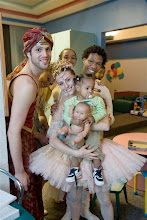Dear Board and Patrons:
This weekend at Clark Opera Center , Ballet Memphis will perform one of the smartest, most creative programs we have ever produced, and you know we have produced a great many of those! Connections: Puppets takes our dancers , and thereby our audiences, to new levels of delight, surprise, and imagination. When Jane Comfort came here to set her work , Underground River, on four of our dancers, she had no idea that our ballet dancers would take her work to this height. Our dancers sing, speak, dance, and manipulate the most beautiful and evocatively simple puppets (by Basil Twist) all the way through the piece. It is , really, something that will take your breath away. I am moved with every rehearsal I am privileged to see. This is a work that is very, very smart on so many levels, and captivating from start to finish.
Lily Cai’s work follows, and anyone who has ever loved a child will be deeply moved . This piece has five women holding baby dolls all the way through the gorgeous Samuel Barber adagio, and the mesmerizing movements’ intensity and heartfelt love of parent for child is the perfect coupling to this rich and penetrating music.
When we get to Travis Bradley’s piece , The Ugly Duckling, prepare to be taken in another direction entirely, with a number of different puppets in a wide range of sizes being moved by the dancers, or dancing with the dancers. This is all on a backdrop of clear, bright color and texture, created and danced with high spirit, but still touching with all with its important message of self-discovery and delight in life.
Jane Comfort is one of the leaders in the world of theatrical dance. Lily Cai used to be a principal dancer with the Shanghai Opera before moving to California , and puppeteer Frank Kane, who has designed the puppets for Travis and is working with the dancers as well as holding a puppet workshop this Saturday afternoon before the performance, worked on Sesame Street with some of the greatest puppets most all of us have come to know and love.
This is not a program to miss. I can’t wait to see and hear your responses after you have experienced it! Thank you again for helping us bring these amazingly creative elements all together.
Most affectionately, and with great excitement,
Dorothy
Monday, March 16, 2009
Tuesday, March 3, 2009
A Connection to Children, Through Puppets
 There is a line from William Wordsworth’s poetry that reads, “The child is father of the man.”
There is a line from William Wordsworth’s poetry that reads, “The child is father of the man.”If we think back upon our childhood toys, or toys that we have given to children, puppets are
likely to be among them. With simple finger or hand puppets, we have actually given our children ways to practice experiencing the world. Calling upon their imaginations, they negotiate and practice their skills through human interactions using these puppets.
For centuries, puppetry has delighted and entertained us, but it has also given us opportunities to extend ourselves into the world of practicing being human. Watching these performances gives us the opportunity to practice again, vicariously, but in a very real sense. It seemed natural to me that when we reach out to objects that personify us as living creatures, as puppets with their nonhuman skin do, we are actually doing the work of digging deeply within.
If you watch the dancers closely in Connections: Puppets, you will see how inevitably they must be apart of the puppets they touch. They must leave their secure place of self-knowing as dancer, and extend to the other, the puppet—and while doing so, the puppet transforms them even as they are transforming bits of material into creatures with life. This is far from their normal dance assignment, different from how they think of themselves or present themselves as dancers. Empathy and attentiveness are demanded in immediate and necessary ways whether the dancers are mother guiding and cradling child, as in Lily Cai’s tender and searing piece, or they are the various emotions and thoughts of little Kara trapped in her world of coma, as in Jane Comfort’s breathtaking and stunning creation. These are works that go straight to the heart of human meaning. They address the consequences of the intense unconditional attachment we have for our children, and the unfathomable love of which we are capable.
The fairytale, too, is a world that helps us confront the human narrative, so it is naturally a rich source for puppetry and dance. We all must know the feeling of being excluded or the yearning to be our most beautiful selves. Travis Bradley, in his search through many stories and fairytales for this project, kept returning to The Ugly Duckling. He had felt like the outcast. Just like our ugly duckling in this performance who is being picked on by everyone and realizes she has to leave, there are times in our lives when we have to leave relationships, bad habits or the unkind messages we may have learned to tell ourselves about our worth. Those are the “dogs” in this ballet, the things that keep us abject. The duckling goes from one place to another, but it is actually a journey of self in which she is engaged.
Would that we all will find the strength in our human characters to shelter, with love and compassion, those who are small, defenseless and with few resources. Would that we all find our true nature. Just as the dancers are moving with their puppets, it is by overcoming our fears and extending our hearts, our minds, our blessings and resources to the other, tthat we move to find the beauty that is our true selves.
Subscribe to:
Comments (Atom)











